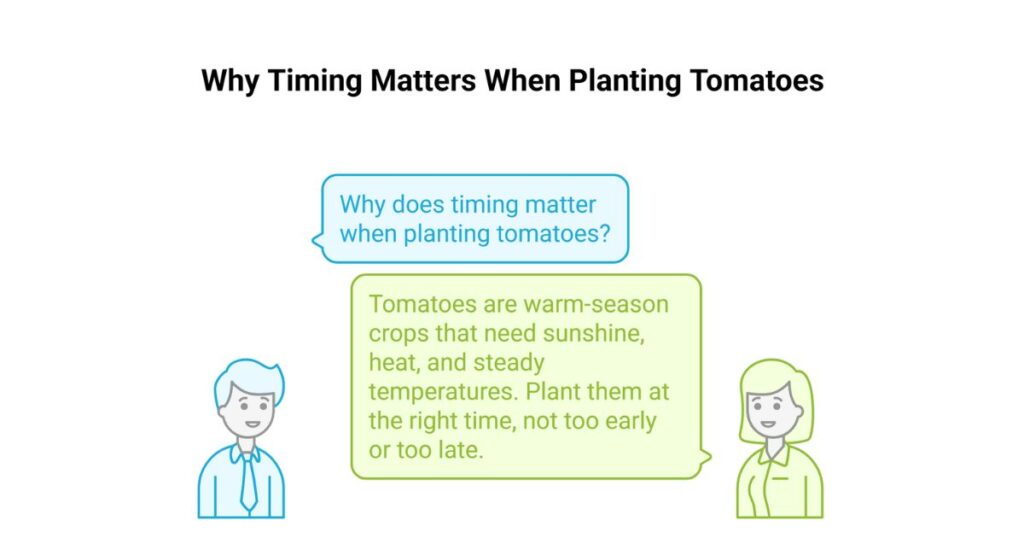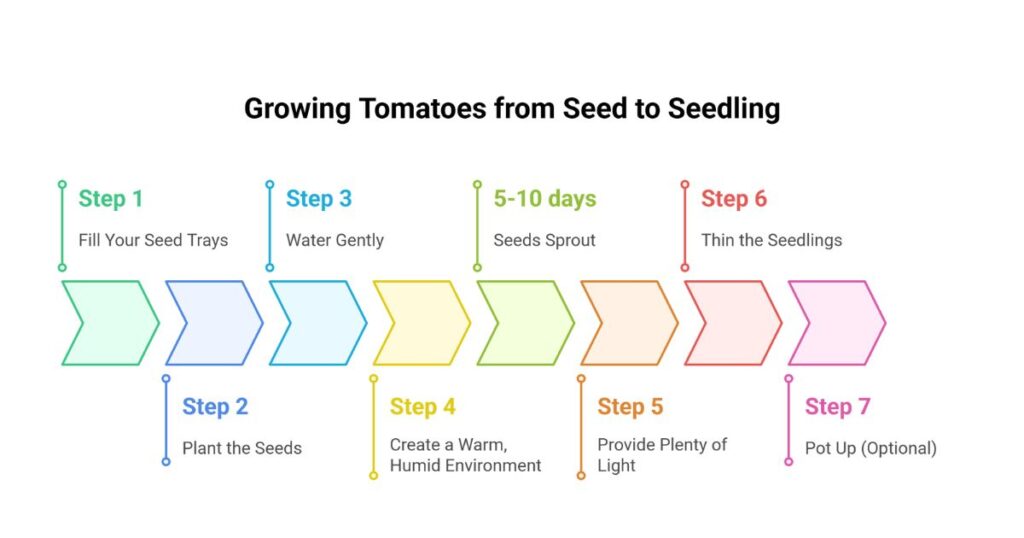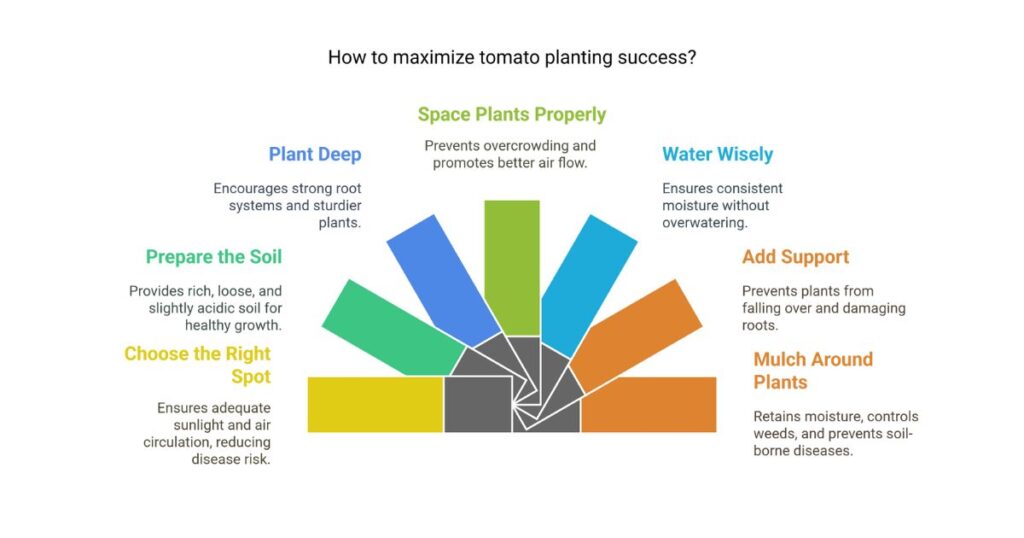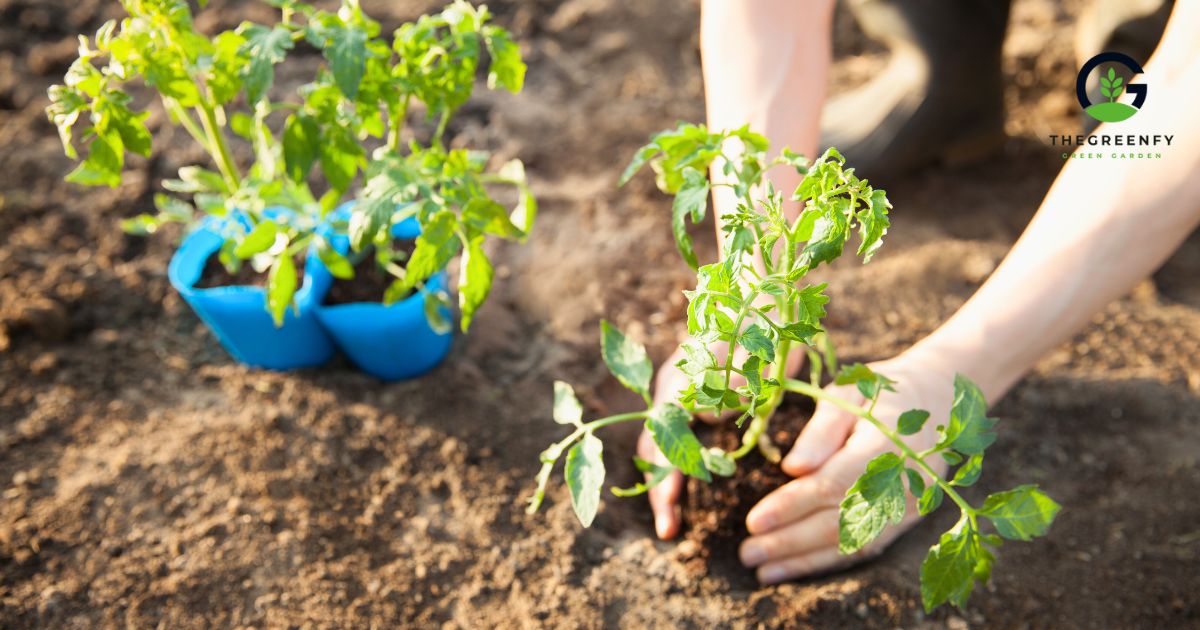Tomatoes are one of the most popular garden crops, and for good reason. They’re juicy, versatile, and surprisingly fun to grow. But if you’re wondering, “What month do you plant tomatoes?”, the answer isn’t one-size-fits-all.
It depends on where you live, your local frost dates, and how you start your plants from seeds or seedlings.
In this guide, we’ll walk you through the best time to plant tomatoes, month by month, and break down everything you need to know to grow a healthy, tasty harvest.
Why Timing Matters When Planting Tomatoes

Timing isn’t just crucial in comedy. It’s everything when planting tomatoes, too.
Tomatoes are warm-season crops. They love sunshine, heat, and steady temperatures. But plant them too early, and they’ll sit in cold soil, struggle to grow, and maybe even die from a late frost.
Plant them too late, and they might not ripen before fall hits. You’ve got to find that “just right” window; that’s why timing matters.
Here’s what happens when you miss the mark:
- Too Early: Cold temperatures can stunt growth, cause root shock, and kill seedlings with a sudden frost. Even if the plant survives, it’ll lag in development.
- Too Late: The plant won’t have enough warm days to flower and fruit. You might get a few tomatoes, but not the heavy harvest you hoped for.
“Think of tomatoes like summer tourists—they arrive when it’s warm and leave before it gets cold.”
Tomatoes need:
- Warm soil (at least 60°F/15°C)
- No frost risk
- Consistent nighttime temps above 50°F (10°C)
That’s why gardeners always say:
“Don’t rush your tomatoes. Wait for the weather to warm up, and they’ll thank you with a bumper crop.”
What Month Do You Plant Tomatoes? (By Zone)

Tomatoes don’t have one perfect planting month for everyone. Why? Because climates vary wildly depending on where you live.
The USA and Canada have growing zones ranging from frigid to tropical, and the best month to plant tomatoes changes based on your USDA Hardiness Zone.
Let’s break it down zone by zone, so you know exactly when to plant tomatoes in your area, whether in frosty Canada or sunny Florida.
Zone 3–5: Cold Climates (Canada, Northern States)
This includes northern Minnesota, Montana, North Dakota, much of Canada, some parts of Maine, and upstate New York.
These are the coldest zones with short growing seasons. If you’re here, you’re no stranger to snow in April and chilly winds in May. Tomatoes won’t survive the cold, so timing is critical.
Planting Schedule for Zones 3–5:
- Start Seeds Indoors: Late March to early April
- Transplant Outdoors: Late May to mid-June, once all frost danger is gone
- Harvest Window: Late August to early October
Key Planting Tips:
- Use fast-maturing varieties: Look for tomatoes that mature in 50–70 days. Some great ones include Early Girl, Glacier, Stupice, and Bush Beefsteak.
- Start seeds indoors under grow lights. These zones often lack natural light early in the season.
- Harden off plants at least one week before transplanting outdoors. Expose them gradually to the sun and wind.
- Use raised beds or black plastic mulch to warm the soil faster in spring.
- Plants should be covered with row covers or mini greenhouses if a late frost threatens them.
“In Zone 3–5, every warm day is gold. The goal is to start early indoors and make the most of your short summer.”
Zone 6–7: Cooler US Regions
This includes Pennsylvania, Ohio, Indiana, parts of New England, Colorado, Northern California, Kansas, parts of Utah, and Oregon.
Zones 6 and 7 offer milder winters and a more generous growing season than zones further north. Still, these zones are not frost-free, and tomatoes must be carefully planted.
Planting Schedule for Zones 6–7:
- Start Seeds Indoors: Mid-February to early March
- Transplant Outdoors: Late April to mid-May, after the last frost date
- Harvest Window: Late July to September
Key Planting Tips:
- Know your frost dates. Even one cold night can undo all your seed-starting efforts. Use a thermometer or local frost calendar.
- Start seeds indoors 6–8 weeks before the last frost. If you’re starting in February, use heat mats and grow lights.
- Transplant when the soil is 60°F+ and nights are above 50°F. Tomatoes hate cold feet!
- Choose indeterminate varieties if you want tomatoes all summer. Try Brandywine, Cherokee Purple, or Black Krim.
- Go with Patio Princess, Bush Goliath, or Tiny Tim for containers.
“Zone 6–7 gardeners are lucky. You have enough time to grow both early and late tomato varieties—and even experiment with heirlooms.”
Zone 8: Milder Winters
This includes Georgia, Alabama, parts of North Carolina and South Carolina, Northern Texas, the Pacific Northwest coastal areas, and Arizona.
Zone 8 is where gardening starts to get exciting. The growing season is longer, and frost comes later and leaves earlier. In some years, you might even squeeze in two tomato harvests!
Planting Schedule for Zone 8:
- Start Seeds Indoors: January to early February
- Transplant Outdoors: Mid to late March
- Harvest Window: Late May to October
Key Planting Tips:
- Start seeds early to get a head start. You can start sowing indoors around New Year’s Day!
- Harden off seedlings carefully to avoid sunburn. A week of gradual sun exposure is enough.
- Choose heat-resistant varieties like Heatmaster, Celebrity, or Arkansas Traveler.
- Plant in full sun, but consider afternoon shade or shade cloth if your summers get super hot.
- Water deeply and mulch heavily; heat and dry soil go hand in hand here.
🌿 Second Crop Opportunity:
In Zone 8, you can plant a second round of tomatoes in mid-July for a fall harvest. Use transplants (not seeds) for the second crop.
“Zone 8 is a tomato paradise but the heat can be brutal. Stay ahead with mulch and regular watering, and your plants will thrive.”
Zone 9–10: Warm Regions (Florida, Texas, Southern California)
This includes most of Florida, South Texas, Southern California, Southern Arizona, and parts of Louisiana and Hawaii.
This is tomato heaven. Zone 9–10 has almost no frost, giving you one of the longest growing windows in the world. You can plant early, plant late, and in many cases, plant all year long (especially in Zone 10).
Planting Schedule for Zones 9–10:
- Start Seeds Indoors: December to January
- Transplant Outdoors: February to March
- Harvest Window: April to June, and again from September to December (fall crop)
Key Planting Tips:
- Take advantage of mild winters to start early.
- Pick varieties bred for heat tolerance: Try Solar Fire, Phoenix, or Heatwave II.
- Use drip irrigation to keep roots cool and soil moist.
- Mulch heavily—it’s your best defense against heat stress.
- Watch for pests like whiteflies, aphids, and tomato hornworms. They’re active early in warm zones.
- Rotate crops each season to prevent soil diseases.
🌿 Double Harvests? Yes!
In these zones, you can often:
- Spring crop: Plant in February, harvest by June.
- Fall crop: Plant again in July or August, harvest by November or December.
“Zones 9 and 10 give you freedom. With proper care, tomatoes can be a year-round treat here.”
Quick Comparison of Tomato Planting by Zone
| Zone | Start Seeds Indoors | Transplant Outdoors | Can Grow 2 Crops? |
|---|---|---|---|
| 3–5 | March–April | Late May–June | ❌ Too cold, short season |
| 6–7 | Feb–March | Late April–May | ❌ One main season |
| 8 | Jan–Feb | Mid–Late March | ✅ Second crop possible |
| 9–10 | Dec–Jan | Feb–March | ✅ Spring & fall crops |
Tomatoes are picky about weather, but anyone can grow a delicious crop with the right month and method. No matter your zone:
- Start indoors early if your growing season is short.
- Wait until after the last frost to plant outside.
- Choose varieties that match your climate—cool-season for the north, heat-tolerant for the south.
- Pay attention to soil warmth, sun exposure, and watering.
🌞 “The best month to plant tomatoes is the one after your last frost, when the soil is warm, and your seedlings are ready to thrive.”
How to Start Tomato Seeds Indoors
Starting tomato seeds indoors is one of the best ways to get a head start on your garden, especially if you live in a zone with a short growing season. It’s like giving your tomatoes a comfy head start before they face the great outdoors.
But don’t worry—you don’t need fancy tools or a greenhouse. A sunny windowsill, some seed trays, and a little attention will do the trick.
Let’s walk through it step by step.
Why Start Tomato Seeds Indoors?
Here’s why indoor seed-starting is so popular:
- You control the environment – Warmth, light, and moisture.
- You beat the frost – While it’s still snowing outside, your tomatoes are growing inside.
- You save money – Seeds are cheaper than nursery plants.
- You get more variety – Many unique heirloom tomatoes are only available as seeds.
“Growing from seed means you’re in control from seed to sauce.”
When to Start Seeds Indoors
Start tomato seeds 6 to 8 weeks before your last frost date. Here’s a rough guide by zone:
| Zone | Start Indoors |
|---|---|
| Zone 3–5 | Late March to April |
| Zone 6–7 | Mid-February to March |
| Zone 8 | January to February |
| Zone 9–10 | December to January |
🌱 Example: If your last frost is around May 15, plant seeds indoors between March 15–April 1.
What You’ll Need
Don’t stress—you don’t need anything fancy. Here’s a simple list:
- Tomato seeds (any variety)
- Seed starting mix (light and fluffy, not garden soil)
- Seed trays or small containers (with drainage holes)
- Humidity dome or plastic wrap (to trap moisture)
- Grow light or sunny window
- Spray bottle for watering
- Heat mat (optional but helpful)
🧂 Pro Tip: Avoid using regular potting soil it’s too heavy and holds too much water for seedlings.
Step-by-Step: Starting Tomato Seeds Indoors

Let’s dive into the exact process:
Step 1: Fill Your Seed Trays
Use a quality seed-starting mix. Moisten it slightly before filling your containers. You want it damp like a wrung-out sponge, not soaking wet.
- Fill trays about ¾ full.
- Gently press down to remove air pockets
Step 2: Plant the Seeds
Plant seeds ¼ inch deep. Make a small hole with your fingertip or a pencil.
- Drop 1–2 seeds per cell or pot
- Lightly cover with the mix and press gently
Step 3: Water Gently
To moisten the surface, use a spray bottle or watering can with a fine spout. Avoid overwatering—seeds don’t like soggy feet.
Step 4: Create a Warm, Humid Environment
Tomato seeds love warmth. The ideal germination temperature is 70–80°F (21–27°C).
- Cover trays with a plastic lid or plastic wrap to hold in heat and humidity.
- Place trays on a heat mat or warm surface.
Seeds should sprout in 5 to 10 days, depending on the variety and conditions.
Step 5: Provide Plenty of Light
As soon as seedlings emerge, remove the cover and give them light.
- Use a sunny south-facing window (at least 6 hours of light/day)
- Or, place under grow lights for 14–16 hours a day
- Keep lights 2–4 inches above the seedlings
Without enough light, seedlings become leggy and weak.
Step 6: Thin the Seedlings
Once the seedlings have two leaves, thin them out by snipping the weaker ones at the soil line.
- This prevents overcrowding
- Stronger seedlings get more space, nutrients, and light
✂️ Don’t pull them out—you might disturb the roots of the healthy seedling.
Step 7: Pot Up (Optional)
If your seedlings outgrow their containers before planting them outside, transplant them into larger pots.
- Use 4–6-inch pots
- Bury part of the stem to encourage stronger roots
Hardening Off: Preparing for the Outdoors
Before transplanting your seedlings outside, they need time to adjust to the sun, wind, and temperature changes. This process is called hardening off.
How to Harden Off:
- Start 7–10 days before transplanting
- Set plants outside in partial shade for 1–2 hours a day
- Gradually increase sun exposure and outdoor time
- Bring them in at night if it’s cold
By the end of the week, they’ll be ready for full days in the sun and life in your garden.
☀️ “Think of hardening off like stretching before a run—it prevents shock and injuries.”
When Can You Plant Tomatoes Outside?
Timing your tomato transplanting is crucial for success. Even the healthiest indoor seedlings won’t survive if planted outside too early.
So, how do you know when the time is right?
✅ Wait Until After the Last Frost
Tomatoes are not frost-tolerant. Plant them too soon, and cold weather can damage or kill them. The golden rule is:
“Plant tomatoes outdoors only after all danger of frost has passed and nighttime temps stay consistently above 50°F (10°C).”
If your area is known for surprise spring frosts, it’s better to wait an extra week than risk losing your plants.
🌡️ Check Soil Temperature, Not Just the Air
Your soil might still be too cold even if the weather feels warm. Tomatoes prefer soil temperatures above 60°F (16°C).
How to Check:
- Use a soil thermometer and insert it 2 inches deep.
- Measure in the morning for accuracy.
- If it’s below 60°F, wait or warm it up with black plastic mulch.
☀️ Sunlight and Weather Matter Too
Tomatoes need full sun, at least 6 to 8 hours of direct sunlight daily. Avoid planting during a rainy stretch or cold snap, even if the frost is gone.
📅 Quick Guide by Region
| Zone | Best Outdoor Planting Month |
|---|---|
| 3–5 | Late May to early June |
| 6–7 | Late April to mid-May |
| 8 | Mid to late March |
| 9–10 | February to early March |
🌱 Tip: If you’re unsure, wait an extra week. A delayed start is better than frostbite!
Tips to Maximize Success When Planting

Once the weather is right and your plants are ready, it’s time to get them in the ground or a pot! But how you plant them can make or break your harvest. Let’s cover everything that gives your tomatoes the best chance to thrive.
🌿 1. Choose the Right Spot
Tomatoes love sunshine. Find a place that gets:
- At least 6–8 hours of direct sunlight daily
- Good air circulation
- Well-drained soil (no puddles after rain)
To reduce disease risk, avoid areas where tomatoes or related crops (like peppers, eggplant, or potatoes) were grown in the past year.
🌱 2. Prepare the Soil
Healthy soil = healthy plants. Tomatoes are heavy feeders and do best in rich, loose, slightly acidic soil.
Do This:
- Mix in compost or well-rotted manure before planting.
- Add balanced fertilizer (like 10-10-10 or organic tomato food).
- Aim for soil pH between 6.2 and 6.8.
🧑🌾 “Feed your soil, and it’ll feed your plants.”
⛏️ 3. Plant Deep—Bury the Stem
Tomatoes can grow roots along their buried stems. Take advantage of that by planting them deeper than they were in the pot—up to the first set of leaves.
Why?
- Encourages strong root systems
- Makes plants sturdier and more productive
You can even plant them sideways in a trench if they’re leggy. The stem will bend upward on its own!
📏 4. Space Plants Properly
Overcrowding tomatoes leads to poor air flow, which increases disease and stress.
General Spacing Guidelines:
- 18–24 inches between plants
- 3 feet between rows
- 1 plant per 5-gallon container (if growing in pots)
💦 5. Water Wisely
Tomatoes need consistent, deep watering, especially in the first few weeks after planting.
Tips:
- Water is at the base of the plant, not the leaves.
- Aim for 1–2 inches of water per week.
- Early morning watering is best.
- Use mulch to retain moisture and reduce weeds.
🚫 Avoid shallow watering—it encourages weak roots and dries out quickly.
🪴 6. Add Support Immediately
Don’t wait until your plant starts falling over; give it support early!
Options include:
- Tomato cages
- Stakes
- Trellises
Add them at planting time to avoid damaging the roots later.
🌾 7. Mulch Around Your Plants
Mulching keeps the soil moist, calm, and weed-free. It also prevents soil-borne diseases from splashing onto your leaves.
Great Mulch Options:
- Straw
- Grass clippings (chemical-free)
- Shredded leaves
- Wood chips (for larger gardens)
Apply 2–3 inches around the base, but keep it away from the stem to avoid rot.
Final Thoughts: Timing Is Everything for Tasty Tomatoes
So, what month do you plant tomatoes?
Well—it depends. 🌎 Your climate zone, frost dates, and soil temperature all play a significant role. But here’s the short answer:
“Plant your tomatoes outdoors when the danger of frost is gone, the nights stay above 50°F, and your soil feels warm to the touch.”
For some, that’s early March. For others, it might be June. And if you’re in Zone 9 or 10? You’re lucky—February and even two full crops per year are possible.
Starting seeds indoors gives you an early lead. Planting deep, spacing wisely, watering properly, and offering support will allow your tomatoes to grow big and juicy.
Whether you’re in a cozy apartment growing cherry tomatoes in pots or on a backyard mission to grow heirlooms, it all starts with the right month.
So grab your calendar, check your zone, and let your tomato adventure begin!
FAQs
Q1: What happens if I plant tomatoes too early?
If you plant before the last frost, your plants could die from cold exposure or become stunted. Even if they survive, they’ll be stressed and won’t grow well. Always wait until nights are above 50°F.
Q2: Can I start tomato seeds directly in the garden?
Yes, in warm zones (9–10). In cooler zones, it’s risky. The soil may stay too cold, and your growing season might not be long enough. Starting indoors gives you a head start.
Q3: How many weeks before planting should I start tomato seeds?
Start seeds 6 to 8 weeks before your last expected frost date. That gives them time to grow strong indoors before moving outside.
Q4: What’s the best time of day to transplant tomatoes?
Early morning or late afternoon is best. Avoid hot midday sun, as it can shock the seedlings. A cloudy day is perfect.
Q5: How can I warm up my soil faster in spring?
Cover your garden bed with black plastic a few weeks before planting. The plastic traps heat and helps raise soil temperatures quickly.










